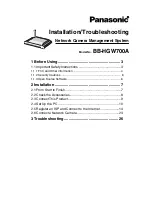
MSI-9000 CellScale
®
System • 3750CS User Guide Page 55
MEASUREMENT SYSTEMS INTERNATIONAL
Software V1-15 to 1-20
RELAY OUTPUT OPTION
This option adds 7 SPDT Relays and 1 Logic Level output to the MSI 3750. The relays can be used in conjunction
with alarms, motors, and other control circuitry to provide a complete automated production line, or to provide
additional information to the scale operator.
Relay Function
The total of 8 set point outputs are addressable through the set point routines of the CellScale. Each set
point output is fully programmable to respond to weight changes. This section is intended to cover the
electro-mechanical details of hooking up and using the set point outputs. For details on programming the set
points, refer to the “SET POINTS” section.
Electrical Specifications
Contacts
Form C, common pin with 1 normally open, 1 normally closed contact
Contact Rating 2A 30V DC, 0.6A 110V DC, 1A 125V AC (not rated for 240VAC!)
Max. Power
60W, 125VA
Expected Life
Mechanical: 10
8
Cycles
Electrical: 10
5
Cycles @ 0.5A 125V AC resistive
Fuse
2A 125V rated SMD fuse (MSI P/N 10473)
Isolation
280VAC 50/60 Hz
Logic Output
1 normally high output, 1 normally low output (not isolated). Fanout:1
TTL load, 25 CMOS loads
Relay Cabling
The Relay connections are made into terminal blocks found on the circuit board internal to the MSI-3750CS.
Due to wash down requirements, use round cable that has an outside diameter of .187” to .312” (5mm to 8mm)
for proper sealing with the watertight fittings. The terminal blocks are suitable for wires from 16 to 24 gauge.
There are up to four watertight fittings dedicated to the Set-Point Outputs (depends on options installed).
Multiple conductor cable will be necessary to access all of the relays.
Cable Installation Procedure
1) Unplug the 3750CS from the AC or DC power source.
2) Remove the 10 screws holding the front panel on.
3) Strip the outer insulation from the cable. Peel back the foil shield (if any) being careful not to nick
the conductors. Cut off the foil shield and the drain wire. Strip 3/16” (5mm) from each conductor and
tin the wires. It is wise to shrink a short piece of heat shrink tubing over the end of the outer jacket
to further insulate the shield.
4) Loosen the watertight feedthroughs and remove the white plugs. Feed the cables through the watertight
feedthroughs.
5) Insert the wires as shown in the following diagram. Push down the white lever with a small screwdriver,
insert the wire, then release the lever. It might be necessary to use needle nose pliers to help insert the
wires into the terminal strips. After all the pins are connected, lightly wiggle and tug on each wire to
ensure that they are securely attached.
6) Tighten the watertight feedthrough around the outer insulation to ensure the water seal.
7) Replace the front panel being careful to seat the gasket evenly around the lip of the cabinet. Screw down the
10 screws in a criss-cross pattern to seat the gasket evenly.
















































